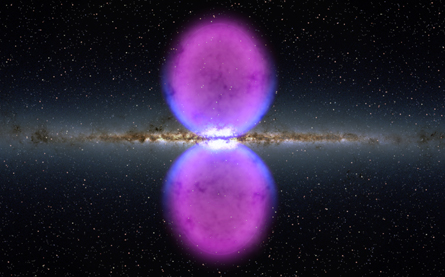The Milky Way is blowing bubbles of cosmic proportions.

Twin bubbles of gamma ray–emitting gas, each the size of a small galaxy, sit above and below the center of the Milky Way like the ends of a giant dumbbell, astronomers have discovered.
Douglas Finkbeiner of the Harvard-Smithsonian Center for Astrophysics in Cambridge, Mass., and his colleagues analyzed data from NASA’s Fermi Gamma-ray Space Telescope to find the bubbles, which may have been generated in the galaxy’s core by a long-ago burst of star formation or by a past eruption from the supermassive black hole believed to lie there. Finkbeiner described the findings, which will appear in the December 1 Astrophysical Journal, during a November 9 telephone briefing.
The bubbles aren’t readily apparent because a high-energy gamma-ray fog, discovered by Finkbeiner and his colleagues last year, fills the sky, mainly due to high-speed electrons and protons interacting with light and interstellar gas in the Milky Way. But when Finkbeiner and his colleagues subtracted the fog from the Fermi telescope’s data they uncovered the two giant lobes.
Far above the plane of the galaxy it’s easy to see the sharp edges of the structures, but closer to the plane, where the gamma-ray emission isn’t as bright as the radiation from the Milky Way’s disk, it’s more difficult to determine if the feature has the hourglass shape characteristic of two connected bubbles, cautioned Gregory Dobler of the University of California, Santa Barbara, who worked with Finkbeiner on an earlier map of the gamma-ray fog. Some models give a geometry that looks like an hourglass while others look more like an oval, Dobler said.
Depending when the bubbles were generated, each lobe could hold as much energy as 100,000 supernovas release, Finkbeiner said. Each bubble has a diameter of about 25,000 light-years, roughly the length of the Large Magellanic Cloud, a satellite galaxy of the Milky Way. In sifting through data taken with other telescopes, hints of the outlines of the bubbles appear as both low-energy X-rays and microwaves, Finkbeiner noted.
One possible source of the bubbles is a proposed wave of starbirth at the galaxy’s center millions of years ago. If a large population of massive stars were born all at the same time, their explosive deaths could have injected enough energy, in the form of energetic electrons or protons, to power the bubbles and cause them to glow with gamma rays. However, previous evidence suggests that the number of massive newborns required to provide the energy would be unrealistically high.
Finkbeiner says he now favors another explanation — jets of material expelled by the supermassive black hole that is thought to reside at the galactic center. At present, the black hole isn’t radiating much. But if it went on a feeding frenzy a few million years ago, the black hole would have hurled jets of material that could easily power the bubbles. “This could be the first evidence” for a major eruption of the supermassive black hole, Finkbeiner said.
Finkbeiner’s team was initially put off by that scenario because it seemed that the black hole’s jets, which should have no special alignment with the surrounding galaxy, would have to blast off exactly perpendicular to the plane of the Milky Way in order to generate the twin bubbles. Finkbeiner said he now realizes that the jets need not have that special alignment, but would naturally inject most of their energy above and below the galaxy’s disk, where the density of gas is lowest and the jets could most easily penetrate.
It’s also possible, he said, that the best explanation could turn out to be a combination of both sources. Supernova explosions from a population of massive stars might have inflated the bubbles, while subsequent jet activity from the black hole might have set the bubbles aglow in gamma rays.
Theorist David Spergel of Princeton University said that he suspects the central black hole, as massive as 4 million suns, is the energy source. Supermassive black holes at the centers of other galaxies are known to drive winds and jets so powerful that they expel heavy elements and gas from the galaxies. The new observations “suggest that our own Milky Way may [also] be driving material outwards,” he said.
When his team first began examining the Fermi data, Finkbeiner noted, the researchers were hoping to find signs of dark matter, the invisible material that makes up most of the mass in the universe. Some proposed types of dark matter would destroy each other upon contact, directly generating gamma rays. In that case, the new results probably wouldn’t change the conclusions of a team who in October announced the possible discovery of dark matter within a few hundred light-years of the galaxy’s center (SN: 11/20/10, p. 11), commented Neal Weiner of New York University.
On the other hand, if dark matter produces gamma rays indirectly by first decaying into other particles such as electrons, then confirming signs of dark matter at the galaxy’s center “is probably out,” Weiner said. That’s because the dark matter–generated electrons might be hurled from the center and into the giant bubbles before having a chance to emit the telltale gamma rays, he suggested.







